Beneath the sleek exterior of an electric bike lies complex machinery that needs to be cared for. These eco-friendly bicycles promise effortless journeys, yet the key to unlocking their full potential lies in meticulous upkeep: you must maintain your electric bikes carefully for smooth, safe, and unlimited rides!
Maintenance isn’t just about ticking boxes – it’s a commitment to an ongoing relationship with your e-bike, where each pedal stroke is met with seamless efficiency and every ride becomes a worry-free adventure. Keep reading as we provide a comprehensive guide on how to maintain your electric bike and the most effective practices to achieve this.
I. Essential Tools and Supplies for Electric Bike Maintenance
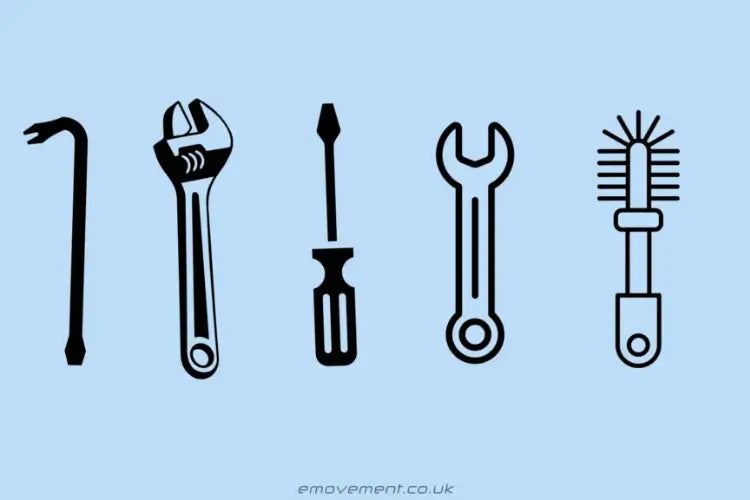
Effective e-bike maintenance begins with assembling the necessary tools and supplies. When you equip yourself with the right gear, you can ensure that your e-bike remains in top condition for safe and enjoyable rides. Here’s what you should consider:
Must-Have Tools for E-Bike Maintenance
There are certain tools that help tackle routine maintenance tasks and keep an e-bike running smoothly:
- Wrenches: A collection of wrenches is indispensable for adjusting various components such as handlebars, saddle, and brakes.
- Cleaning Brushes: Cleaning brushes in varying sizes are essential for keeping your e-bike free from debris and maintaining its overall appearance, especially coloured bikes like E-Movement’s Pixie Series.
- Tire Levers: Changing punctured tubes becomes a straightforward task with tire levers, allowing riders to quickly get back on the road without hassle.
- Torque Wrench: One precise tool that enables tightening bolts to the recommended specifications is a torque wrench, as it prevents over-tightening and potential damage.
Choosing the Right Lubricants and Cleaners
Proper lubrication and cleaning are key to preserving your electric bicycle’s performance and lifespan:
- Chain Lube: Using the right chain lubricant minimises friction, reduces wear, and extends an e-bike’s life and drivetrain components.
- Degreasers: Degreasers effectively remove built-up dirt and grime from your drivetrain, restoring efficiency and preserving the performance of your bike.
- Bike-Specific Cleaners: Formulated to be gentle yet effective, these cleaners maintain your e-bike’s aesthetic while removing dirt, mud, and other contaminants.
- Silicone Spray: This versatile spray offers protection against moisture and corrosion, which is especially vital for exposed electrical connections.
The Importance of Quality Tools
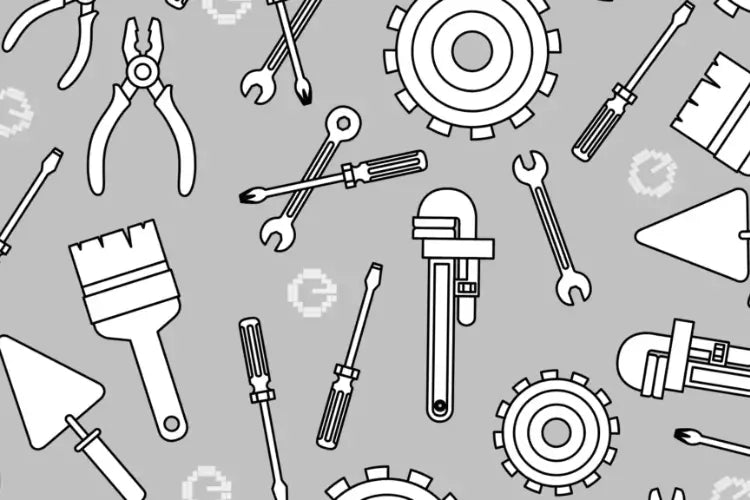
Quality tools are an investment in the longevity and reliability of your electric bike. Let’s take a look at some crucial factors to consider when purchasing these tools:
- Durability: High-quality tools are built to withstand the rigours of maintenance tasks, ensuring they remain functional over time.
- Precision: Accurate adjustments are crucial for optimal e-bike performance, and the right tools provide the precision required for fine-tuning.
- Component Protection: If you want to minimise the risk of causing damage to delicate components and maintain your electric bike’s appearance, you should invest in quality tools.
- Reliability: Trustworthy tools instil confidence in your maintenance routine, guaranteeing that your e-bike is cared for with dedication.
By meticulously assembling a toolkit that embodies quality, versatility, and precision, you can lay a solid foundation for efficient e-bike maintenance. These tools empower riders to keep their bikes in prime condition for countless exhilarating rides ahead.
II. Tyre Care and Pressure Management
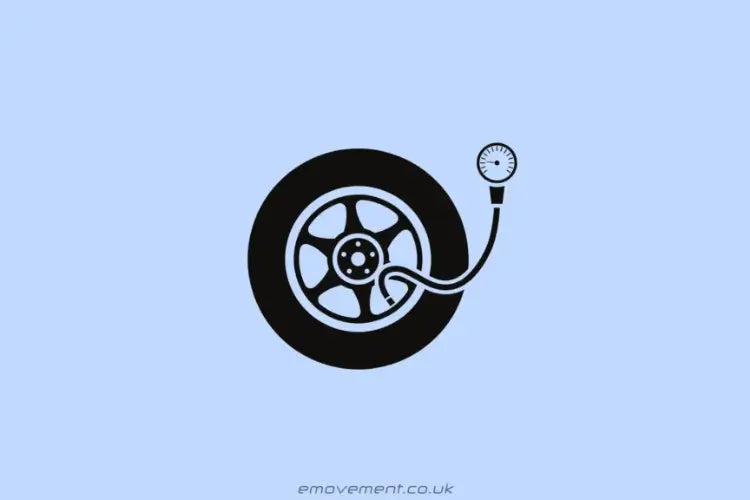
Proper tyre care stands as a cornerstone within electric bike maintenance practices, impacting not only your e-bicycle’s handling but also its overall efficiency. In this section, we’ll delve into the significance of maintaining optimal tyre pressure and the step-by-step process for effective tire inspection and maintenance.
The Importance of Proper Tyre Pressure:
The equilibrium between handling and efficiency is achieved by maintaining the recommended tyre pressure:
- Enhanced Handling: Adequate tyre pressure ensures a firm grip on the road, optimizing cornering and steering responsiveness.
- Efficiency Boost: Properly inflated tyres reduce rolling resistance, enhancing an e-bike’s overall efficiency and extending battery range.
Step-by-Step Tyre Inspection and Maintenance
Regular tyre inspections and maintenance routines help keep your e-bike safe and in top shape, both on and off roads. Here are some essential steps to follow when carrying out these routines:
- Checking Tread Wear and Sidewall Damage: Examine your tyre’s tread for signs of wear, which impacts grip and control. Additionally, inspect sidewalls for cuts or damage that could compromise its integrity.
- Inflating Tyres to Recommended Pressure Levels: Proper inflation is essential if you want to enjoy efficient electric bike performance. For this reason, use a reliable pressure gauge to inflate your tyres to the manufacturer’s recommended levels.
- Balancing Pressure for Front and Rear Tires: Maintaining consistent pressure between front and rear tyres promotes balanced handling and stability during rides, enhancing overall control.
By adopting these steps and tips, you’ll be able to navigate various terrains with ease and relish in the seamless functionality and mechanisms of your e-bike.
III. Battery Management and Longevity
Responsible battery management is a pivotal practice that enables your e-bike’s battery to remain a reliable and enduring power source. By understanding charge cycles, temperature considerations, and various charging habits, riders can boost their battery’s longevity and overall riding experience.
Maximising Battery Lifespan
Taking deliberate steps to preserve your e-bike battery life safeguards both your investment and riding comfort:
- Understanding Charge Cycles: Every charge cycle – encompassing a full discharge from 100% to 0% and its subsequent recharge – influences your battery’s overall health. Minimising complete charge cycles whenever possible helps prolong its lifespan.
- Temperature Control: The battery’s sensitivity to temperature extremes is a crucial factor, meaning that it’s in your best interest to shield it from excessive heat or cold. These conditions can affect its immediate performance and long-term durability.
Charging Best Practices and Avoiding Common Mistakes:
Your battery’s well-being is intrinsically linked to your charging habits, so let’s consider some effective charging practices and common mistakes you should avoid:
- Avoiding Overcharging and Deep Discharging: Overcharging places undue stress on the battery, while allowing it to discharge too quickly can contribute to gradual damage. Aiming for a charge range between 20% and 80% is an effective way to mitigate these stress points.
- Ideal Storage Charge Level for Longevity: During an extended storage period, maintain the battery at approximately 50% charge to prevent extreme discharges and sidestep the risks of overcharging in these prolonged periods of inactivity. Additionally, store your charger in a secure place that you’ll remember.
When you embrace these battery management practices, you’re not only enhancing the life expectancy of your e-bike’s battery but also nurturing a more dependable and consistent power source for thrilling adventures.
IV. Chain and Drivetrain Maintenance
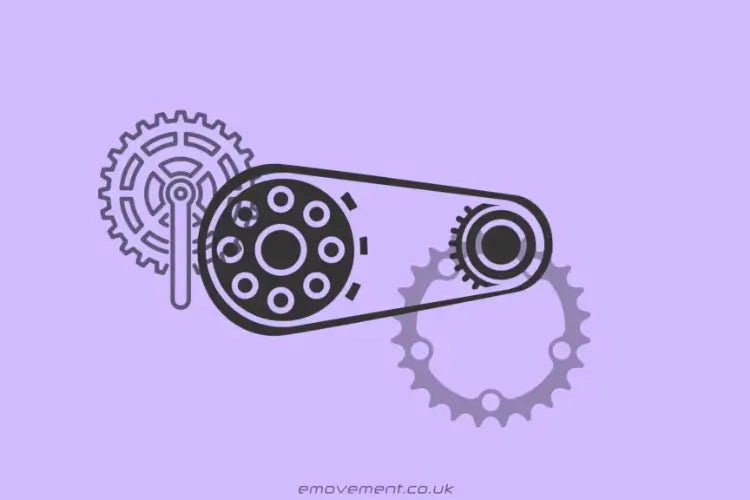
At the heart of your e-bike’s performance lies the chain and drivetrain, which are essential for powering rides on various terrains. This section uncovers the simple yet crucial steps to maintain these vital components for your vehicle’s longevity and efficiency.
Chain Cleaning and Lubrication Techniques
A well-maintained chain ensures optimal power transfer and reduces wear on the drivetrain. You can achieve this by:
- Cleaning with Degreaser and Soft Brushes: Regularly cleaning the chain with a suitable degreaser and soft brush removes dirt and grime, preventing excess friction that can lead to premature wear.
- Applying Lubricant and Wiping Off Excess: After cleaning, apply the right chain lubricant and ensure you wipe off any excess. This maintains smooth and efficient chain movement without attracting additional dirt.
Detecting and Addressing Chain Wear
Identifying and addressing chain wear prevents more significant issues down the road. If you want to use your bike for extended ranges without inconveniences or interruptions, incorporate the following procedures in your e-bike maintenance routine:
- Checking for “Stretch” and Chain Replacement: Use a chain wear gauge to monitor for excessive stretching. Replacing a stretched chain before it damages other drivetrain components is paramount for longevity.
- Maintaining a Properly Lubricated Drivetrain: A well-lubricated drivetrain reduces friction, wear, and noise. Regular application of chain lube keeps your electric bike running smoothly.
The right chain and drivetrain maintenance techniques Will improve your bike’s core performance for convenient and thrilling rides. Additionally, you can prolong the life of your e-bike’s essential parts and make every pedal stroke a joy.
V. Brake System Maintenance
An electric bike’s brake system is more than a mechanism – it’s the primary line of defence and control on the road. As you navigate bustling streets or venture through serene trails, the ability to decelerate swiftly and with confidence is indispensable. In this section, we explore the nuanced realm of brake system maintenance and the intricate care required to achieve smooth braking performance, regardless of the terrain or conditions encountered.
Types of E-Bike Brakes
Tailoring your maintenance approach to the specific brake type is essential for rider safety:
-
Mechanical Brakes:
Mechanical brakes rely on cables and levers to initiate stopping power. Regularly assess cable tension to ensure your brakes respond promptly and reliably. Additionally, check for proper pad alignment. Misaligned pads can lead to uneven wear and reduced stopping power, compromising your ability to halt safely.
-
Hydraulic Brakes:
The fluid-based nature of hydraulic brakes demands meticulous attention. Monitor brake fluid levels frequently, and maintain them within the manufacturer’s recommended range to enjoy responsive and reliable braking performance. Additionally, examining rotor and pad conditions prevents diminished stopping power and allows you to command your e-bike with confidence.
Brake Pad Inspection and Replacement
Within the brake system, the brake pads bear the brunt of the stopping force. They are an e-bike’s critical components for responsive braking, so keep the following things in mind regarding their inspection and replacement:
- Evaluating Pad Thickness and Wear Patterns: Regular inspection of your brake pad thickness is crucial because excessively worn pads compromise your ability to stop effectively and increase the risk of damaging the rotor. You should also scrutinise wear patterns for even contact with the rotor. Uneven wear might signal underlying alignment issues that need addressing.
- Proper Alignment and Bedding-In of New Pads: When the time comes to replace brake pads, meticulous care is necessary to uphold their functionality. Precise alignment between the pads and the rotor surface guarantees uniform contact and optimal stopping power. This is followed by the crucial step of “bedding-in” new pads. By gradually engaging the brakes and applying increasing force, you allow the pads to conform to the rotor’s contours and ensure they provide reliable deceleration.
Immersing yourself in these comprehensive brake system maintenance practices results in your electric bicycle responding quickly and seamlessly when you need it most. A nurtured brake system is an investment in your confidence, enabling you to embark on every ride knowing that your stopping power remains at its peak no matter what lies ahead.
VI. Frame and Component Upkeep

Every e-bike’s frame and intricate components establish the foundation for its ride quality, and there are many frames to choose from. These include step-through bike frames, road legal frames, fat-tyre e-bike frames, and more. A well-maintained frame makes riding comfortable while also assuring a safer journey. Let’s take a look at how you can preserve your e-bike’s structural integrity and safeguard its overall functionality to ensure every route you take is a breeze.
Cleaning Your E-Bike (Dos and Don’ts for Different Materials):
Effective cleaning is the cornerstone of frame and component maintenance, but not all materials are created equal. Here are some dos and don’ts to consider when it comes to component upkeep:
- Do’s: Utilize mild, bike-specific cleaners and soft brushes for gentle removal of dirt and grime. Pay special attention to crevices and hard-to-reach areas where debris is likely to accumulate.
- Don’ts: Avoid high-pressure water sprays that can force water into delicate components and refrain from abrasive brushes or harsh chemicals that might compromise your e-bike’s finish.
- Preserving Electric Components: When cleaning, exercise caution around electric components such as the motor and battery. Try to steer clear of excessive moisture exposure to prevent potential damage.
Tightening Bolts and Components for Safety
Keeping your electric bike’s components securely fastened is beneficial for both safety and performance reasons:
- Importance of Regular Checks to Prevent Loosening: Vibrations and regular usage can cause bolts and components to loosen over time. Regularly inspect and tighten them to avoid potential hazards and maintain consistent performance.
- Using Proper Torque Values to Avoid Over-Tightening: You can achieve precise tightening by using a torque wrench and adhering to manufacturer-recommended torque values. Try not to over-tighten components as this leads to damage, compromising both components and the frame.
- Focusing on Critical Bolts: Pay extra attention to critical bolts that secure components like the handlebars, stem, and seatpost. Ensuring their proper torque prevents accidents and enhances riding stability.
If you look after your e-bike’s frame and components, you’ll be able to nurture a relationship of trust between you and your two-wheeled companion. Every cleaning and tightening action echoes your commitment to a safe, smooth, and reliable journey.
VII. Suspension Maintenance (If Applicable)
For riders possessing electric bicycles equipped with suspension systems, the diligent upkeep of these components plays a pivotal role in ensuring a ride characterized by seamless comfort and unwavering control across different terrains.
Preserving Suspension Performance
Suspension maintenance necessitates a specialized approach to sustain peak performance and longevity. Here’s what you should focus on:
- Attending to Seals: A regular ritual of cleaning suspension seals eradicates accumulated dirt, staving off wear and bolstering overall performance. Employing the right lubricants preserves the seals’ pliability, resulting in ongoing efficiency.
- Vigilance Against Leaks: Conduct periodic examinations for potential oil leakage within the suspension system. Swiftly addressing such concerns maintains the enduring functionality of this critical system.
Adjustments for Different Riding Conditions
When you fine-tune a bike’s suspension settings to the demands of diverse landscapes, you can enjoy both comfort and control:
- Establishing Sag: Mastering sag adjustment—pertaining to the suspension’s compression under the rider’s weight—holds the key to excellent performance. We recommend consulting manufacturer guidelines if you want to achieve the perfect sag configuration.
- Refining Rebound Dynamics: Once you’re able to navigate rebound adjustments, you can dictate the velocity at which the suspension restores itself post-compression. This parameter profoundly influences both traction and control, with adaptability based on terrain nuances and individual preferences.
- Tailoring Compression Response: By fine-tuning compression settings, riders sculpt the suspension’s reaction to external impacts. A customised approach to compression aligns comfort with handling finesse, adapting seamlessly to each terrain’s requirements.
Understanding the intricate realm of suspension system care and adjustments signifies a direct investment in elevating your e-bike’s ride quality. The outcome is a blend of comfort, precision, and confidence that seamlessly translates across diverse landscapes, propelling you forward with every pedal stroke.
VIII. Display and Control Unit Care
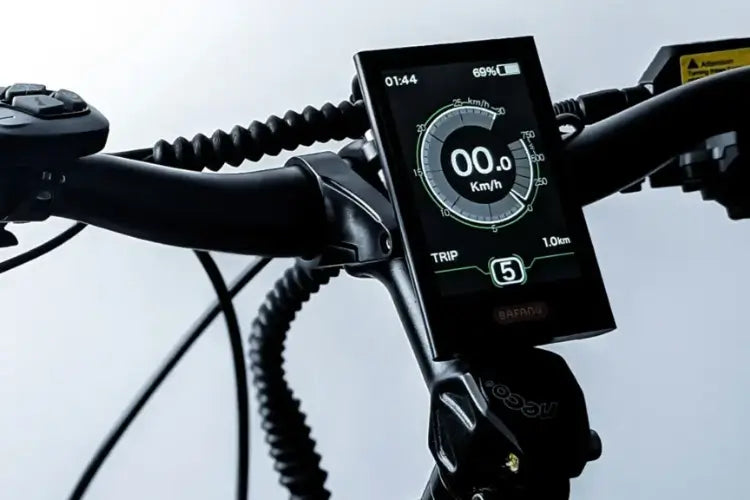
Along with the mechanical intricacies of an electric bike, the display and control unit stands as the digital hub that connects riders to vital information and control. Ensuring its effective functionality holds significance for a seamless riding experience.
Cleaning and Protecting Display Screens
The display screen acts as a portal into your bike’s operations, demanding vigilant care:
- Gentle Cleaning Practices: Employ soft, lint-free microfiber cloths to delicately wipe away dust and smudges from the display screen, preserving its clarity and readability.
- Invest in Screen Protectors: Augmenting your care regimen, a high-quality screen protector offers an additional layer of safeguarding against potential scratches and damage from environmental factors.
Understanding and Troubleshooting Display Issues
A comprehensive grasp of the display unit’s functions and potential issues enables riders to navigate challenges adeptly. Let’s consider how you can tackle various troubleshooting display problems:
- Staying Current with Software Updates: Regularly check that your display unit’s software remains up to date. This practice grants access to new features and protects it against potential bugs that might hinder its performance.
- Performing Resets: In the face of intermittent glitches, a soft reset can often serve as a quick remedy. Your electric bike manual should detail the reset process, aiding in restoring functionality.
- Seeking Professional Support: If persistent issues arise, don’t hesitate to lean on customer support or your e-bike manufacturer. Their expertise can illuminate solutions and alleviate any complications you might encounter.
You can fortify the bridge between the digital realm and a tangible riding experience by thoughtfully tending to your electric bicycle’s display and control unit. With a consistently clear screen and unwavering functionality, you’re primed to harness your e-bike’s capabilities to their fullest extent and push forward on journeys using a newfound sense of clarity and control.
IX. Electrical Connections and Troubleshooting

Pertaining to your e-bike components’ intricacies, electrical connections hold a pivotal role in delivering seamless performance. Familiarising yourself with these connections and troubleshooting potential issues helps add to a consistently reliable and thoroughly enjoyable ride.
Inspecting and Cleaning Electrical Connectors
Properly working electrical connections form the bedrock of an electric bike’s optimal performance and unwavering dependability:
- Identifying Corrosion: Regular check-ups help unveil the presence of corrosion within connectors, which can hinder the smooth flow of electrical currents. A simple cleaning with recommended agents can help restore conductivity.
- Ensuring Solid Connections: Bolstering an e-bike’s performance requires attention to the snugness of connectors. It’s in your best interest to confirm secure fastening because it prevents intermittent connections responsible for disrupting the seamless flow of power.
Common Electrical Problems and Solutions
Becoming proficient in identifying and addressing typical electrical issues is like having a toolkit for troubleshooting in the electrified world:
- Diagnosing Cut Wires: If you encounter cut or damaged wires, a quick fix involves sealing them with electrical tape or heat-shrink tubing. This simple step reinstates their integrity and insulation.
- Addressing Malfunctions: When electrical components misbehave, start by checking connections for any looseness. If the issue persists, consult your e-bike’s manual or seek professional help to untangle the complexity.
When you comprehensively understand electrical connections and embrace effective troubleshooting techniques, you can create a riding experience of smooth and efficient performance. It then translates into confident exploration and joyful rides due to the developed trust in your electric bike’s capabilities.
X. Professional Servicing and Annual Checks
Electric bike owners often find themselves manoeuvring the balance between DIY maintenance and seeking expert assistance. In this section, we’ll explain professional servicing and annual checks, shedding light on when to entrust your bicycle to experts for complicated repairs and comprehensive tune-ups.
When to Seek Professional Maintenance: Complex Repairs and Tune-Ups
While basic maintenance can be handled in your own garage, certain scenarios call for the help of professionals:
- Navigating Complex Repairs: In the case that you encounter intricate mechanical or electrical issues beyond your expertise, you should consult an e-bike technician to ensure proper diagnosis and resolution.
- Embracing Annual Check-ups: Regular annual visits to a professional e-bike mechanic provide an opportunity for in-depth assessments, preventive maintenance, and component evaluations.
What to Expect During an E-Bike Tune-Up
Here’s what to expect from an electric bicycle tune-up:
- Thorough Inspection: A skilled mechanic conducts a meticulous assessment of your bike’s components, identifying areas that require attention.
- Lubrication and Adjustments: Essential moving parts receive lubrication to provide smooth operation. Additionally, precise adjustments are made to brakes, gears, and other critical systems for the best possible e-bike performance.
Although DIY maintenance is useful and applicable in most cases, professional expertise adds a layer of meticulous care and strategic investment that extends the life of your e-bike and guarantees a seamless and enjoyable journey for every ride you set out on.
XI. Storage Tips for E-Bikes
As your cycling journeys wind down, the task of storing your e-bike assumes importance. Here, we dive into practical storage insights, focusing on how to shield your e-bike from potential risks and maintain its optimal condition when it’s time to ride again.
Storing Your E-Bike Safely and Efficiently
A secure storage approach involves protecting your e-bike from various threats that could compromise its integrity:
- Protection from Theft: Enhance security by using reliable locks or a sturdy U-lock. For added safety, consider storing your e-bike indoors, especially in high-risk areas.
- Shielding from Extreme Weather: If outdoor storage is unavoidable, invest in a weatherproof bike cover designed specifically for electric bike dimensions. This protective layer shields your e-bike from rain, snow, and other harsh elements that could accelerate wear and tear.
- Guarding Against UV Exposure: Extended exposure to direct sunlight can lead to fading paint and potential damage to electronic components. Whenever possible, opt for storing your e-bike in a shaded area or use UV-resistant covers to minimize sun-related harm.
Preparing Your E-Bike for Long Periods of Inactivity

When preparing your e-bike for storage over an extended period, a few proactive steps can significantly extend its lifespan and ensure peak performance:
- Partial Battery Charge: Prior to storage, aim to maintain the bike’s battery charge level between 30-50%. This prevents the battery from staying at full charge or discharge, which can lead to long-term capacity loss.
- Lubrication and Cleaning: Apply a bicycle-specific lubricant to the chain, derailleur pivots, and brake components. A protective layer prevents rust formation and keeps the moving parts nimble during idle periods. Additionally, giving your e-bike a thorough cleaning before storage prevents dirt and grime from embedding itself.
- Utilizing Covers: A well-fitted cover serves as a simple yet effective safeguard against dust accumulation, moisture, and potential scratches when the e-bicycle is in storage. By using a cover, you’re adding an extra layer of protection that contributes to your e-bike’s overall longevity.
Delving into the intricacies of e-bike storage and implementing these strategies is helpful if you want an electric bike that remains in peak condition during rest periods. When you’re ready to hit the road once more, your e-bike will deliver the same reliability, efficiency, and enjoyment that you’ve come to expect.
FAQ: Common Questions About E-Bike Maintenance
1. How often should I clean my e-bike?
Regular cleaning, at least once every couple of weeks, keeps dirt and debris from accumulating and potentially damaging components. Washing frequency can vary according to your riding conditions and terrain.
2. Can I wash my bike with water?
You can use water for cleaning, but exercise caution around electrical connections and sensitive components. Opt for a gentle spray and avoid high-pressure washers that could force water into unwanted areas.
3. What’s the ideal tire pressure for my electric bike?
Check your electric bike manual or the sidewall of your tire for the recommended pressure range. Generally, it falls between 40-65 PSI (pounds per square inch), but it’s essential to find the right balance between comfort and performance.
4. Should I remove the battery when not using the e-bicycle?
If you’re storing your e-bike for an extended period, it’s recommended to remove the battery and store it in a cool, dry place with around 30-50% charge. This helps prevent over-discharge and capacity loss.
5. How can I tell if my brake pads need replacing?
Regularly inspect your brake pads. In the case that they’re worn down to around 1-2mm or show significant wear patterns, such as uneven thickness or grooves, it might be time to replace them to maintain effective braking.
6. Are there different lubricants for e-bike chains?
Specific e-bike chain lubes are available. These lubes are designed to handle the higher torque demands of electric bicycles and are more effective in preventing wear, corrosion, and friction on e-bike drivetrains.
7. What’s the best way to store an electric bike during winter?
Store your e-bike in a dry place away from extreme cold and dampness, as moisture can lead to corrosion. Inflate the tires to the recommended pressure to prevent flat spots and consider removing the battery to prevent temperature-related damage.
8. Why is my display showing inaccurate battery levels?
Battery level readings can fluctuate due to factors such as temperature, load, and battery age. To improve accuracy, calibrate your battery periodically by fully charging and discharging it.
9. When should I consider professional e-bike maintenance?
If you encounter complex issues beyond your expertise, such as electrical problems or major mechanical repairs, it’s wise to consult a professional e-bike mechanic to ensure proper diagnosis and repair.
10. How can I prolong the lifespan of my battery?
To extend your e-bike battery’s lifespan, avoid exposing it to extreme temperatures, don’t store it fully charged for extended periods, and aim for regular use to prevent long periods of inactivity, which can lead to capacity loss.






















































































